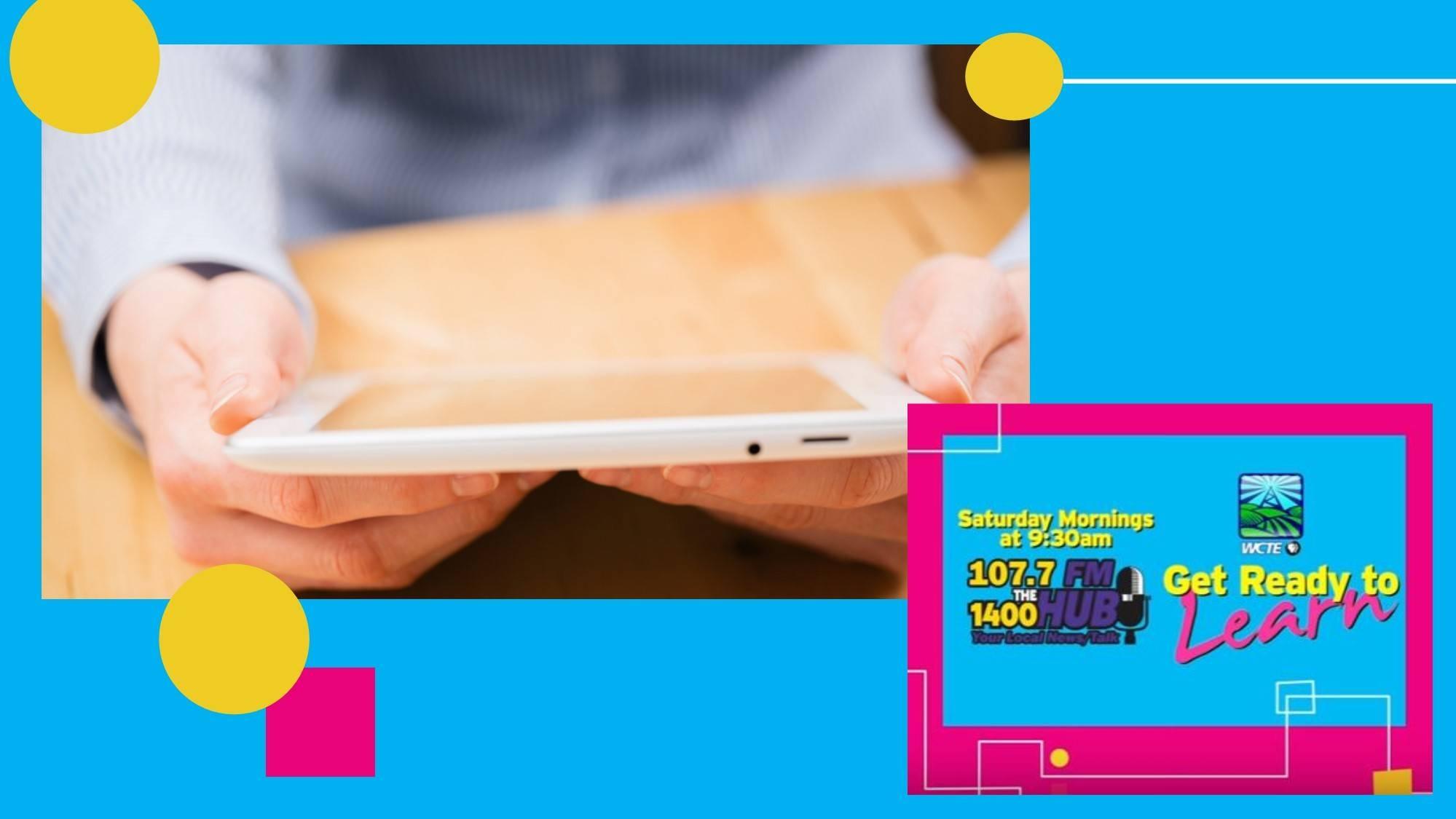Media is all around us, making its way into our experiences practically 24/7 and it can be a useful tool or a huge distraction. Researchers say in 2109 people will use media for about 170.6 minutes each day.
Join WCTE’s Get Ready To Learn host Cynthia Putman as she welcomes WCTE Intern and TTU Sr. Communication major Emily Jones for a discussion about media, including social, mobile devices, screen time and how we all reply on our cell phones. They also share helpful information from Sara Dewitt for parents. As Vice President of PBS KIDS Digital, Sara DeWitt leads innovative strategies to build connected and immersive educational experiences for kids across media platforms, including the Kidscreen and Webby-award winning pbskids.org. DeWitt has led the extension of PBS KIDS content into new frontiers – from mobile apps and interactive whiteboard games, to wearable tech and 3D-rendered gaming.
Says DeWitt, “At PBS KIDS Digital, I spend my days working on the development of high-quality digital media for young kids. Despite the focus of my day job, when I go home to my own two young kids, I also experience the stress of managing family screen time. There are so many mixed messages surrounding the topic of screen time, and I sometimes struggle to make sure I’m making the right choices about when and what my kids watch and play. It helps to remember digital media is simply a tool, just like books, toys, and art supplies. As parents, we have the power to decide how and when to use these tools with our kids.”
DeWitt goes on to say, “With that in mind, I want to share some effective approaches for making the most of digital technology use at home. Just like meal planning and school activity scheduling, it takes a little bit of time up-front, but things will be easier once you have a plan.”
She advises that you start your plan by asking yourself these two questions:
Question 1: What do I want my kids to get out of their digital media time?
For example, are you trying to give them a little down time after school? Are you concerned about their social and emotional skills? Do you want to help get them energized before time outside? Your answers will help you decide whether you choose a relatively calm show like Daniel Tiger’s Neighborhood or a digital game that encourages movement, like Wild Kratts’ World Adventure.
If you’re hoping for something educational, let your child’s interests be your guide. Look for programs and digital games that feature characters or topics that your child loves. If you start with an area that sparks your child’s curiosity, they are likely to be more engaged with the content.
Also, look for positivity. Are the characters in this show or game modeling good behavior and problem-solving skills? Your child learns a lot by observing how other people engage with one another.
Not sure where to start? Common Sense Media is a great source for age-appropriate ratings and educational information. All of the educational goals of PBS KIDS shows are here on PBS Parents. And your child’s teacher, daycare provider, or librarian is likely to have some great recommendations. Take a few minutes to check out a new show, game, or app first; you know your child best, so you can probably guess what they will like.
Question 2: What do I most need out of my kids’ digital media time? How can it support our family schedule and priorities?
Let’s be honest with ourselves: sometimes we need our kids to be occupied for 30 minutes while we get dinner ready or take a shower. So take your needs into consideration, too. What is going to be the best time of day for your child to watch a show or play a game? If it’s while you’re putting a younger child down for a nap, you will want to choose an activity that is relatively quiet and easy for your child to play on their own, like the Cookie Monster’s Challenge app or Daniel’s Grr-ific Feelings. If it’s while you’re making dinner, you might want a show that is age-appropriate and engaging for kids of multiple ages, like Curious George or Nature Cat.
Next Steps: Implement Your Family Media Plan
Once you have answered these questions and selected some digital media options for your kids, you’re ready to implement the media plan for your family.
1. Communicate the plan to your kids, and be clear about limits. Make your screen time plans clear to your kids. For example, in my household we have a “show chart” that outlines the number of 30-minute media blocks my older son can have each day, and when. On school days he can watch a show while he gets dressed and drinks his milk, but it has to be one his younger brother will also enjoy. After school, he can use his block to play a tablet game or watch a show, and he can choose from the PBS KIDS options I’ve put on the home screen of the family iPad.
There are special occasion times: family movie night, media use when we’re traveling, and sometimes a little time to play on a tablet while waiting for a doctor’s appointment. As a family, we’ve decided that we never use media in restaurants and instead encourage coloring or playing games like “what’s missing.”
2. Make sure you TALK about what your kid played or watched. If you aren’t watching with them, try to overhear a little of what your child is doing on screen, and establish the idea that media is something to talk about. This might sound like: “What happened on the show today?”; “How did Peg solve her big problem?”; “Wow – what would you do if your friend didn’t want to play your game?”; or “How did you get over that big jump in the game?”
Encourage kids to tell you the story of what they watched, or what they think they learned in the game. And introduce the idea that you can have opinions about media. If you watch a movie together as a family, talk about what each person liked or didn’t like, and see if you can have a discussion about it. In addition to letting your child practice good communication skills, you are helping them be critical thinkers about what they see on the screens around them.
3. Find a balance of activities. It’s important to find the right balance of TV, interactive screen time, and off-screen activities for your family. That said, you can use media in tandem with hands-on activities. For example, if the kids in Dinosaur Train start a nature collection, suggest a nature walk through your neighborhood after they’ve watched. If your child likes Ready Jet Go, use the Ready Jet Go Space Explorer app to look at the stars together. In other words, we can make digital media as a jumping off point for family fun!
More helpful info about media usage can be found here, on PBS Parents.
Check out the PBS KIDS Playtime Pad Mobile Lab at the Putnam County Library, which includes tablets loaded with PBS KIDS apps that are available for check-out!





